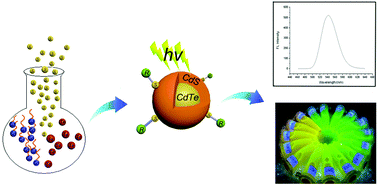An investigation of preparation, properties, characterization and the mechanism of zinc blende CdTe/CdS core/shell quantum dots for sensitive and selective detection of trace mercury
Abstract
In this paper, we report a green, ultrafast and facile aqueous preparation of highly luminescent core–shell CdTe/CdS with significant stability under atmospheric pressure. The surface topography, size, physical shape as well as crystalline structures were studied fully and in depth by adopting a variety of analytical methods such as transmission electron microscopy (TEM) and X-ray diffraction (XRD). The possible mechanism involved in the core growth was proposed and the relevant processes were conjectured too. In this study, we presented a convenient label-free fluorescence nanosensor for the rapid determination of trace mercury, which exhibited many advantages, such as a high sensitivity, excellent selectivity, a rapid response time, a wide linear range and a low limit of detection (LOD). The LOD is down to 1.7 × 10−9 mol L−1, which is lower than that of most other detection methods for mercury.


 Please wait while we load your content...
Please wait while we load your content...